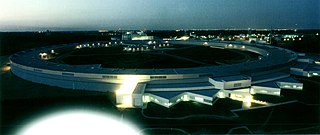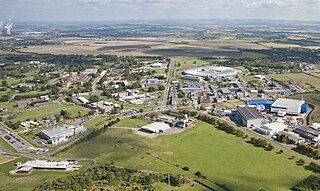Related Research Articles

Oak Ridge National Laboratory (ORNL) is a federally funded research and development center in Oak Ridge, Tennessee, United States. Founded in 1943, the laboratory is now sponsored by the United States Department of Energy and administered by UT–Battelle, LLC.

SLAC National Accelerator Laboratory, originally named the Stanford Linear Accelerator Center, is a federally funded research and development center in Menlo Park, California, United States. Founded in 1962, the laboratory is now sponsored by the United States Department of Energy and administrated by Stanford University. It is the site of the Stanford Linear Accelerator, a 3.2 kilometer (2-mile) linear accelerator constructed in 1966 that could accelerate electrons to energies of 50 GeV.

Argonne National Laboratory is a federally funded research and development center in Lemont, Illinois, United States. Founded in 1946, the laboratory is owned by the United States Department of Energy and administered by UChicago Argonne LLC of the University of Chicago. The facility is the largest national laboratory in the Midwest.

The Advanced Photon Source (APS) at Argonne National Laboratory is a storage-ring-based high-energy X-ray light source facility. It is one of five X-ray light sources owned and funded by the U.S. Department of Energy Office of Science. The APS began operation on March 26, 1995. It is operated as a user facility, meaning that it is open to the world’s scientific community, and more than 5,500 researchers make use of its resources each year.
The Center for Nanophase Materials Sciences is the first of the five Nanoscale Science Research Centers sponsored by the United States Department of Energy. It is located in Oak Ridge, Tennessee and is a collaborative research facility for the synthesis, characterization, theory/ modeling/ simulation, and design of nanoscale materials. It is co-located with Spallation Neutron Source.
The Laboratory for Laser Energetics (LLE) is a scientific research facility which is part of the University of Rochester's south campus, located in Brighton, New York. The lab was established in 1970 with operations jointly funded by the United States Department of Energy, the University of Rochester and the New York State government. The Laser Lab was commissioned to investigate high-energy physics involving the interaction of extremely intense laser radiation with matter. Scientific experiments at the facility emphasize inertial confinement, direct drive, laser-induced fusion, fundamental plasma physics and astrophysics using the Omega Laser Facility. In June 1995, OMEGA became the world's highest-energy ultraviolet laser. The lab shares its building with the Center for Optoelectronics and Imaging and the Center for Optics Manufacturing. The Robert L. Sproull Center for Ultra High Intensity Laser Research was opened in 2005 and houses the OMEGA EP laser, which was completed in May 2008.

The United States Department of Energy National Laboratories and Technology Centers is a system of laboratories overseen by the United States Department of Energy (DOE) for scientific and technological research. The primary mission of the DOE national laboratories is to conduct research and development (R&D) addressing national priorities: energy and climate, the environment, national security, and health. Sixteen of the seventeen DOE national laboratories are federally funded research and development centers administered, managed, operated and staffed by private-sector organizations under management and operating (M&O) contracts with the DOE.

The Rutherford Appleton Laboratory (RAL) is one of the national scientific research laboratories in the UK operated by the Science and Technology Facilities Council (STFC). It began as the Rutherford High Energy Laboratory, merged with the Atlas Computer Laboratory in 1975 to create the Rutherford Lab; then in 1979 with the Appleton Laboratory to form the current laboratory.

The Spallation Neutron Source (SNS) is an accelerator-based neutron source facility in the U.S. that provides the most intense pulsed neutron beams in the world for scientific research and industrial development. Each year, this facility hosts hundreds of researchers from universities, national laboratories, and industry, who conduct basic and applied research and technology development using neutrons. SNS is part of Oak Ridge National Laboratory, which is managed by UT-Battelle for the United States Department of Energy (DOE). SNS is a DOE Office of Science user facility, and it is open to scientists and researchers from all over the world.

The ISIS Neutron and Muon Source is a pulsed neutron and muon source, established 1984 at the Rutherford Appleton Laboratory of the Science and Technology Facilities Council, on the Harwell Science and Innovation Campus in Oxfordshire, United Kingdom. It uses the techniques of muon spectroscopy and neutron scattering to probe the structure and dynamics of condensed matter on a microscopic scale ranging from the subatomic to the macromolecular.

The European Spallation Source ERIC (ESS) is a multi-disciplinary research facility currently under construction. The ESS is currently under construction in Lund, Sweden, while it's Data Management and Software Centre (DMSC) is situated in Copenhagen, Denmark. The 13 European member countries are partners in the construction and operation of ESS. ESS is scheduled to begin its scientific user program in 2023, with the construction phase set to be completed by 2025. ESS will enable scientists to observe and understand basic atomic structures and forces, which is not achievable with other neutron sources in terms of lengths and time scales. The research facility is located close to the Max IV Laboratory, which conducts synchotron radiation research. The construction of the facility began in the summer of 2014 and the first science results are planned for 2023.

The University of Florida Training Reactor (UFTR), commissioned in 1959, is a 100 kW modified Argonaut-type reactor at the University of Florida in Gainesville, Florida. It is a light water and graphite moderated, graphite reflected, light water cooled reactor designed and used primarily for training and nuclear research related activities. The reactor is licensed by the Nuclear Regulatory Commission and is the only research reactor in Florida.

A neutron research facility is most commonly a big laboratory operating a large-scale neutron source that provides thermal neutrons to a suite of research instruments. The neutron source usually is a research reactor or a spallation source. In some cases, a smaller facility will provide high energy neutrons using existing neutron generator technologies.

The Los Alamos Neutron Science Center (LANSCE), formerly known as the Los Alamos Meson Physics Facility (LAMPF), is one of the world's most powerful linear accelerators. It is located in Los Alamos National Laboratory in New Mexico in Technical Area 53. It was the most powerful linear accelerator in the world when it was opened in June 1972. The technology used in the accelerator was developed under the direction of nuclear physicist Louis Rosen. The facility is capable of accelerating protons up to 800 MeV. Multiple beamlines allow for a variety of experiments to be run at once, and the facility is used for many types of research in materials testing and neutron science. It is also used for medical radioisotope production.

John M. "Jack" Carpenter was an American nuclear engineer known as the originator of the technique for utilizing accelerator-induced intense pulses of neutrons for research and developing the first spallation slow neutron source based on a proton synchrotron, the Intense Pulsed Neutron Source (IPNS). He died on 10 March 2020.
The Zero Gradient Synchrotron (ZGS), was a weak focusing 12.5 GeV proton accelerator that operated at the Argonne National Laboratory in Illinois from 1964 to 1979.
The National User Facilities are a set of large-scale scientific facilities maintained by the U.S. Department of Energy, Office of Science, whose roles are to provide the scientific community with world-leading scientific instruments to enable research. These facilities are generally free to use, and are open to scientists from all over the world, usually through the submission and evaluation of research proposals.
Argonne Fast Source Reactor (AFSR) was a research reactor which was located at the Argonne National Laboratory, a United States Department of Energy national laboratory, facility located in the high desert of southeastern Idaho between Idaho Falls, Idaho and Arco, Idaho.
Yanglai Cho was a Korean physicist.
References
- ↑ Raymond G. Teller (25 January 2008), Message From the Director, Argonne National Laboratory, archived from the original on 15 March 2019, retrieved 19 December 2016